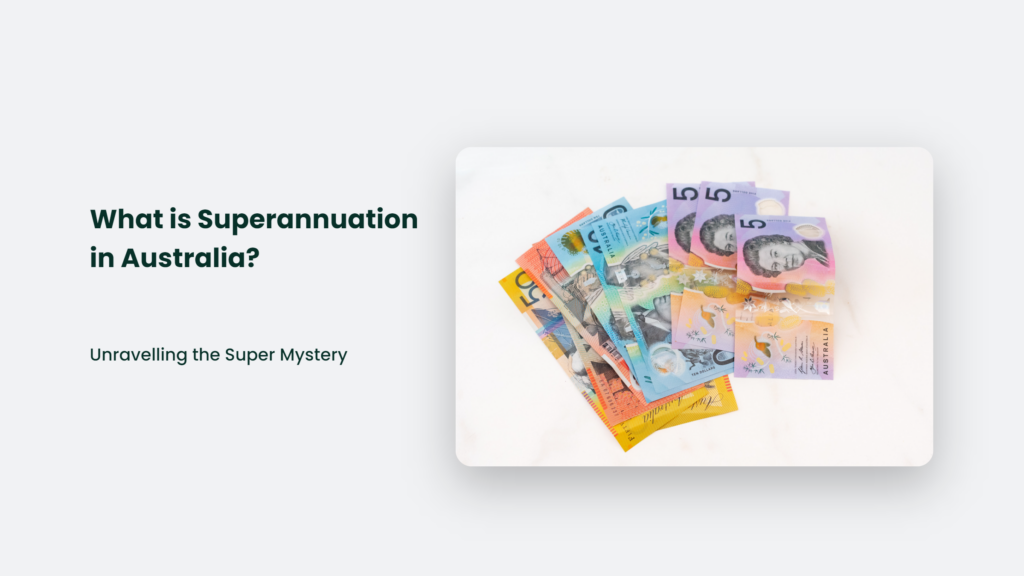Superannuation, or “super” as it’s commonly known, is a retirement savings system in Australia that involves money earned by an employee being placed into an investment fund to be made legally available to fund members upon retirement. But what exactly is superannuation, and how does it work?
In this article, we’ll dive into what is superannuation in Australia, exploring its history, how it functions, and why it’s essential for your financial future. So, buckle up and get ready to unravel the super mystery!

What is Superannuation in Australia?
Superannuation began in 1992 under the Keating Labor government. Before then, superannuation existed in Australia but was not widespread and was paid at the discretion of employers, usually solely to white-collar workers in the private sector. From July 1, 1992, under the system now known as the Superannuation Guarantee (SG), employers were required to make superannuation contributions on behalf of their employees.
How Superannuation Works
Under the Australian superannuation system, employers make compulsory payments to these funds at a proportion of their employee’s wages. As of 2023, the mandatory minimum contribution is 10.5%. This percentage figure is referred to as the “superannuation guarantee.” As of March 30 2022, Australians have AU$ 3.5 trillion invested as superannuation assets, making Australia the 4th largest holder of pension fund assets in the world.
Accumulation vs. Defined Benefit Funds
There are two types of super funds: defined benefit funds and accumulation funds. Most super funds are accumulation funds, where your money grows or ‘accumulates’ over time, and the value of your super depends on the money that you and your employers put in (known as super contributions) and the investment return generated by the fund after fees and costs.
Contributions and Investment Options
Employers must pay a minimum amount based on the current super guarantee rate of your ordinary time earnings into super. You can also add more money to your super by choosing the best option, like before or after-tax contributions. When you join a super fund, you’ll automatically be invested in the default investment option unless you choose another investment option.
The Power of Superannuation: Examples and Statistics
To illustrate the impact of superannuation on Australians’ financial futures, let’s look at some statistics and data:
- As of March 2023, total superannuation assets were $3.5 trillion, with total MySuper assets increasing by 5.1% over the March quarter of 2023 to $964.5 billion.
- For the year ending December 2022, Superannuation Guarantee (SG) contributions ($88.5 billion) accounted for around three-quarters of employer contributions.
- The rate of return (ROR) for entities with more than six members for the December 2022 quarter was 3.7%, and for the year was -5.5%, a significant decrease compared with the annual ROR for December 2021 (12.9%)
Frequently Asked Questions:
What is the difference between superannuation and retirement?
Superannuation is a retirement account that Australians can use to fund their retirement, while retirement means building enough wealth not to need to work again.
Can I choose my own super fund?
Yes, when you start a job, you can usually either choose a super fund or let your employer choose for you. Most funds offer a simple, low-fee option called a MySuper product, which is the default product your employer will use for you.
What happens to my super if I’m a temporary resident leaving Australia?
If you are a temporary resident working in Australia and you are eligible for super, your employer has to make super guarantee contributions for you5. When you leave Australia, you can apply to have your super paid to you as a Departing Australia Superannuation Payment (DASP).
The Bottom Line:
Superannuation is a crucial aspect of financial planning for Australians, providing a secure and stable foundation for retirement. By understanding the ins and outs of superannuation, you can make informed decisions about your financial future and ensure a comfortable retirement. So, now that you’ve unravelled the super mystery, it’s time to take control of your superannuation and secure your financial future!




